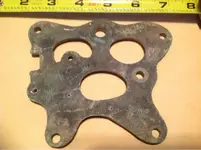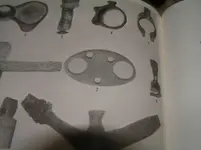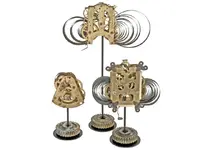JDug wrote:
> Cannonball guy knows everything doesn't he.
No, I don't. It's just an illusion I've (unintentionally) created by only answering questions I already know the answer to. ;-)
This object is proof that I can't ID everythng. At "first glance" of the photo I immediately thought clock-part frame, because it does resemble one. But, as the photo posted by DCMatt shows, the main body of clock-part frames are a square, a rectangle, a circle, or (very rarely) triangular with a curved bottom. This object's body does not match any of that geometric patterns.
Also, some of the holes in it show the imprint of heavy bolts or nuts, which are not needed in clocks. A clock's guts are not heavy enough to require heavy-duty nuts/bolts. Nor are they subjected to repetitive "serious" vibration, like a carburetor or other engine-part is. If it's from a clock, it must have been from really heavy one.
Another curious aspect of this object is the presence of the square-cornered "notch-out" on its left edge. Don't see that sort of thing on clockwork-frames.
The only other things I can say about it:
1- It does "more closely" resemble a carburetor component or other engine component than anything else I'm familiar with.
2- Being at least 1/8-inch thick, it seems to have been made for some kind of heavy-duty service.







